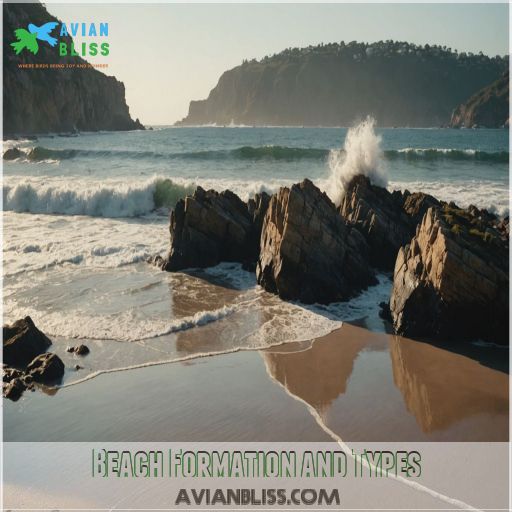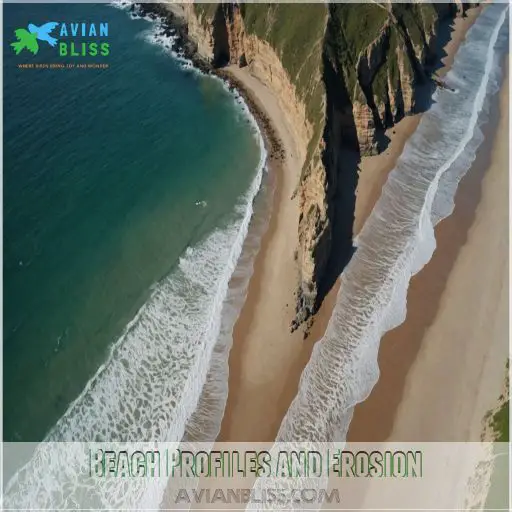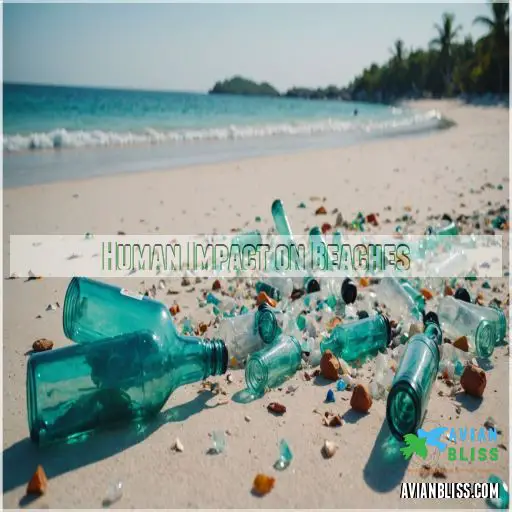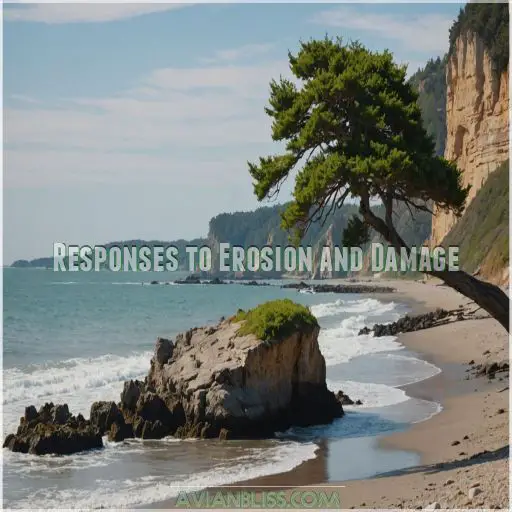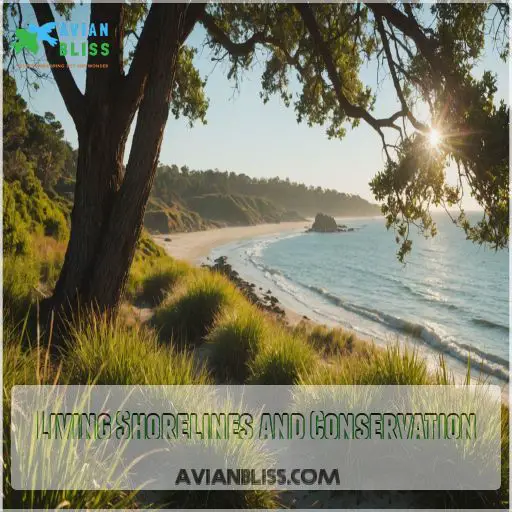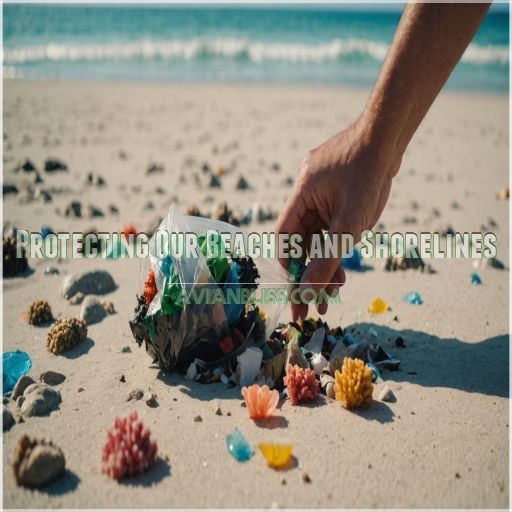This site is supported by our readers. We may earn a commission, at no cost to you, if you purchase through links.
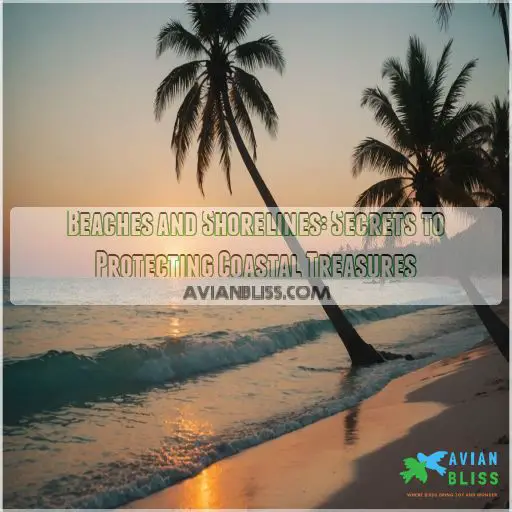 You love beaches and shorelines, right? They’re humble strips of land where land meets water, but they’re so much more. Sandy shores, rocky cliffs, and coral reefs all have unique stories to tell.
You love beaches and shorelines, right? They’re humble strips of land where land meets water, but they’re so much more. Sandy shores, rocky cliffs, and coral reefs all have unique stories to tell.
They form through erosion and weathering, with sand from reefs and seashells swirling around. Longshore drift might sound like a dance move, but it shapes these beaches by shuffling sand around.
Erosion’s in the spotlight as rising sea levels and human activities threaten coastlines. Don’t touch that dial! Our next sections reveal how communities can protect these coastal treasures, ensuring they’re around for sunbathing and sandcastles.
Table Of Contents
- Key Takeaways
- Beach Formation and Types
- Shoreline and Coastal Landforms
- Beach Profiles and Erosion
- Human Impact on Beaches
- Responses to Erosion and Damage
- Living Shorelines and Conservation
- Beaches and Shorelines in Jeopardy
- Protecting Our Beaches and Shorelines
- Frequently Asked Questions (FAQs)
- What is the difference between a beach and a shoreline?
- What is the shoreline of the beach?
- How do I access public beaches in my area?
- What are the rules for using private beaches?
- How can I report beach erosion or damage?
- What is the process for building a new dock?
- How do I get involved in beach conservation efforts?
- Conclusion
Key Takeaways
- Beaches are dynamic landscapes where land and water meet. They change with the seasons like the dance between summer sand accumulation and winter erosion. Look closely, and you’ll see how longshore drift moves sand like a flowing river, shaping these sandy retreats.
- Our favorite beaches face significant threats from erosion, pollution, and rising sea levels. Imagine trying to sip your drink while the ocean slowly creeps up the straw! Climate change is no joke, but with the right actions, we can keep our coastlines intact.
- You can be a superhero in flip-flops by getting involved in beach conservation efforts. Every piece of trash you pick up at a beach cleanup shifts the tide towards a healthier planet. Think of it as giving back to your sunny, sandy vacation home.
- sustainable tourism and beach management are the perfect duo, like sunscreen and a beach towel. Embrace eco-friendly choices to protect these natural playgrounds. Remember, happy beaches make for happy sunbathers—always leave only your footprints behind!
Beach Formation and Types
When you stroll on a beach, you’re walking on a unique mix of sand, pebbles, and seashell fragments, crafted by nature’s mighty forces of weathering and erosion.
These coastal wonders come in various types, from sandy shores to coral wonders, each with their own story about waves, tides, and geological magic.
Beach Materials and Composition
Imagine strolling along a beach, sand tickling your toes—it’s not just sand, folks! Beach materials can include various seashell types, mineral-rich sand, colorful pebbles, and rock fragments.
These elements tell a story of beach erosion and nourishment.
Coastal vegetation often stabilizes these materials, ensuring your sandy paradise doesn’t slip into the sea. Embrace nature’s coastal artistry!
Sources of Beach Sand
Most beach sand comes from a variety of sources, including eroded bits of nearby rocky reefs, weathered quartz from inland cliffs, and even tiny seashell fragments.
Beach sand composition can vary widely depending on the local geology and coastal processes.
Some beaches, like those near river mouths, are muddier due to sediment carried downstream.
Weathering and Erosion Processes
As beach sand comes from various sources, it faces weathering and erosion, nature’s unstoppable artists.
Picture waves sculpting coastlines like ambitious painters.
Erosion wears coastal landforms down, creating wave-cut cliffs and ever-changing beach types.
Engage with living shorelines for a natural masterpiece.
They buffer these erosive forces with grace, balancing freedom and protection, while enhancing your coastal legacy.
Beach Profiles and Seasonal Changes
Weathering and erosion shape beaches, leading to intriguing changes in beach profiles. In winter, erosion takes center stage, while summer brings sand accretion.
Imagine the beach face like a dance floor, changing partners as wave energy shifts.
The swash zone and wrack line become storytellers of seasonal sand movement, influenced by longshore currents and tidal flats.
Barrier Beaches and Barrier Islands
Understanding beach profiles helps to appreciate barrier beaches and barrier islands.
Imagine them as nature’s frontline soldiers—they take the brunt of storm surges.
These dynamic landforms, teeming with wildlife habitats, evolve continually.
Tidal inlets shape and separate them, while coastal management aims to mitigate coastal erosion and environmental impacts, safeguarding these treasures and their ecosystem services for future generations.
Coral Beaches and Reefs
Coral beaches, found in tropical regions like the Caribbean, are a sight to behold.
These powdery white sands are actually the eroded exoskeletons of tiny coral polyps.
But these vibrant reefs face threats like bleaching, acidification, and overfishing.
To protect these underwater oases, support marine conservation efforts and sustainable reef tourism.
Your visit can make a difference!
Shoreline and Coastal Landforms
You’re about to uncover the fascinating secrets of shoreline and coastal landforms, where nature’s artistry shapes beaches and cliffs, sculpts deltas, and builds reefs.
Imagine Mother Nature as the quirky architect who uses waves and sediment to constantly redesign her sandy creations while teaching us how to protect and enjoy these coastal treasures.
Beach Berm and Intertidal Zone
Explore the fascinating world of the beach berm and intertidal zone.
These areas act like nature’s palette, with berm colors changing as sands shift.
They’re also bustling with intertidal life, living on the edge — quite literally!
Storm impacts alter the landscape rapidly, but watch out for those rip currents!
Enjoy the carefree interplay of land and sea.
Cliffed Coasts and Abrasion
Ever stood on a cliff and felt the wind whip around you? That fierce wind, teamed with relentless waves, carves stunning cliffed coasts over time.
Avoid the abyss by understanding these effects:
- Cliff erosion rates: Rising sea levels accelerate them.
- Wave action impact: Contributes to cliff collapse risks.
- Coastal protection methods: Implement solutions like barriers or sea stacks for safety.
Delta Formation and Sediment Deposition
Deltas form as rivers carrying sediment reach a body of water.
The river’s flow expands, decreasing velocity and allowing sediment to build up.
Over time, channel-switching and mouth bar deposition create intricate distributary networks.
Understanding delta formation is key to managing coastal regions, as these dynamic landforms influence habitats, resources, and human activity.
Reefs and Barrier Islands
Picture reefs as living sculptures from the ocean floor, boasting unique beauty and offering ecosystem services.
Barrier islands form nature’s coastal shields, weathering ocean currents and storm impact.
Imagine exploring Western Australia’s Shark Bay with its Mesozoic-era rudist bivalves.
Remember:
- Reef formation shapes habitats.
- Barrier island types vary.
- Preserve ecosystem services.
- Study geological history.
Living Shorelines and Natural Coastlines
From vibrant reefs and barrier islands, nature’s marvels continue with living shorelines.
These natural defenses work like a charm, enhancing coastal resilience and erosion control.
By using plants, sand, and rock, living shorelines restore marine habitats while mimicking natural processes.
Picture a quiet hero, fighting the tide.
Imagine the Great Salt Lake’s beauty or the Louisiade Archipelago’s tranquility.
Beach Profiles and Erosion
You’re about to uncover how beaches constantly fight against the forces of erosion, like a sandcastle against relentless waves.
Understanding longshore drift and those mysterious sandbars will help you appreciate the delicate dance of sediment transport and illuminate why beach nourishment is as important as your morning coffee.
Longshore Drift and Sandbars
Along the coast, longshore drift – the movement of sand and sediment parallel to the shore – sculpts sandbars, those undulating underwater ridges that protect beaches. These sandbars shift with the tides and currents, providing a natural buffer against erosion.
To maintain healthy beaches, understanding longshore drift is key, like knowing where to replenish sand or how to work with coastal currents.
- Longshore drift shapes sandbars, shifting with tides and currents
- Sandbars act as a natural barrier, protecting beaches from erosion
- Coastal currents and tides influence sandbar formation and movement
- Beach nourishment projects can help replace sand lost to longshore drift
- Sandbars may also contain valuable resources like fossil fuels or ore deposits
Erosion Causes and Effects
Hold onto your hats—erosion’s a big deal! Coastal erosion bites away at beaches, spurred by sea level rise, storm surges, and human impact.
Think of it as nature’s relentless sculptor chiseling away, sometimes faster than your patience with slow Wi-Fi.
Coastal armoring and sediment loss didn’t help the Cambrian or Ordovician periods, and they won’t assist modern beaches either!
Littoral Cell and Sediment Transport
Erosion may steal the show, but the littoral cell quietly orchestrates your beach’s sediment dance. This invisible conveyor belt moves sand around, like waves high-fiving the shore.
By managing the sediment budget, you help shoreline evolution continue naturally.
Wave action plays director here, shaping coastal erosion with Mother Nature’s rhythmic hand. It’s a delicate balance, just like surfing life’s ups and downs!
Beach Nourishment and Restoration
Longshore drift might make you feel like you’re moving in circles, but don’t worry! Beach nourishment techniques can refresh your favorite sandy spots. By replacing eroded sand from sustainable sources, you can restore beauty without breaking the bank. Toss in some environmental considerations, and you’ve got a recipe for keeping beaches pristine. Who knew sand had such a story?
Human Impact on Beaches
Beaches and coastlines around the world face growing threats from human activities.
From seawalls and harbors to coastal development, our actions can have serious environmental consequences – but there are also sustainable solutions to protect these precious natural treasures.
Seawalls and Coastal Protection
Picture yourself walking on a beautiful sandy beach, but a seawall stands guard against stormy seas. Seawalls, a form of coastal armoring, can be effective for erosion control, yet they may push problems elsewhere.
Remember, there’s a fine dance between nature and protection.
Maybe living shorelines offer a more harmonious tune, blending safety with environmental nourishment.
Groins and Breakwaters
Ever wondered how coastal structures like groins and breakwaters impact beaches?
By managing sediment transport, they help control coastal erosion, enhancing beach nourishment and protecting shorelines.
Picture these as guardians holding back the tide’s relentless force.
Groins and breakwaters, when designed effectively, can be the unsung heroes of erosion control, offering safety and preserving our sandy retreats for future beachgoers.
Harbors and Coastal Development
Managing harbors and coastal development feels like dancing on a tightrope. It’s a balancing act involving harbor design and coastal zoning to handle ship traffic without stepping on Mother Nature’s toes.
Coastal zoning laws aim to control tourism impact, yet everyone wants their slice of paradise.
Environmental regulations help, but sometimes you’ve just got to roll with the tides.
Environmental Impacts and Consequences
Coastal development and human activities can have devastating impacts on beaches and shorelines.
From sea level rise and coastal pollution to habitat loss and beach erosion, the consequences of our actions are clear.
But by understanding these challenges, we can work together to protect these precious natural treasures for generations to come.
Sustainable Beach Management
As awareness grows around the environmental impacts and consequences of beach tourism, sustainable beach management becomes a key player in the game.
You’ll find managing waste akin to battling a hydra; cut one head, two appear!
Focus on erosion control, coastal restoration, and climate adaptation – they’re your trusty steeds to keep beaches pristine for your community and future generations.
Responses to Erosion and Damage
When facing beach erosion, you might picture a sandcastle slowly losing its battle against the waves, but there’s more to it.
You can engage with various preservation techniques like planting sturdy dunes or using clever shoreline stabilization methods to protect these beloved coastal areas.
Beach Preservation Techniques
When battling beach erosion, you’ve got a few tricks up your sandy sleeves. Consider effective methods like:
- Beach nourishment: Adding sand to increase width.
- Erosion prevention: Implement groins or jetties.
- Seawall alternatives: Use natural barriers for resilience.
- Coastal resilience: Create living shorelines.
Remember, preserving beaches is like baking; mix and match techniques for the perfect outcome!
Dune Restoration and Vegetation
Restoring coastal dunes and planting hardy beach grasses are game-changing ways to safeguard your shoreline. These natural barriers shield against erosion, storm surges, and rising tides. Opt for native species that thrive in your climate – they’ll grow deep roots to anchor the sand and boost coastal resilience. It’s a win-win for you and the environment!
| Dune Planting | Beach Grass | Erosion Control |
|---|---|---|
| Stabilizes sand | Traps windblown sand | Protects against storms |
| Enhances biodiversity | Requires minimal maintenance | Adapts to changing conditions |
| Improves flood protection | Beautifies the landscape | Supports native ecosystems |
Shoreline Stabilization Methods
While restoring dunes is like giving a beach a fresh haircut, shoreline stabilization methods offer more diverse solutions.
Living shorelines, like nature’s hugging arms, work by mimicking natural defenses.
Consider seawall alternatives such as beach nourishment or coastal armoring; they combat erosion while maintaining the coast’s natural beauty.
Remember, it’s easier to prevent coastal hiccups than fix them!
Coastal Erosion Control Measures
To tackle coastal erosion, explore a mix of seawall effectiveness and natural barriers like living shorelines.
They’re the unsung heroes of erosion prevention, bolstering coastal resilience.
Sure, living shoreline costs may vary, but they’re often lower than rigid methods.
Embrace nature’s wisdom—think of these solutions as your coastline’s best defense team, working tirelessly to keep your beaches safe and sound.
Living Shorelines and Conservation
You’ve probably heard the saying, "Nature knows best," and living shorelines prove it by working naturally to protect coastlines.
By focusing on these sustainable solutions, you can help preserve your favorite beach spots without breaking the bank or needing a PhD in marine biology.
Benefits of Living Shorelines
Living shorelines are a game-changer for coastal communities. They don’t just look beautiful – these natural, protected edges also pack a powerful punch, shielding your home from erosion, purifying your water, and even attracting incredible wildlife. Plus, they cost less to install and maintain than traditional seawalls. What’s not to love?
Living shorelines offer a range of benefits to coastal communities:
- Enhance coastal resilience
- Provide wildlife habitat
- Improve water quality
Designing and Implementing Living Shorelines
Designing a living shoreline is like crafting a garden designed for sea life. Begin with choosing living shoreline materials and conducting a cost analysis to fit your budget.
| Task | Details |
|---|---|
| Permitting process | Navigate local regulations |
| Plant selection | Pick native species |
| Monitoring success | Track shoreline changes |
| Maintenance strategies | Regular debris removal |
Enjoying your safer, thriving shoreline is priceless!
Site Analysis and Planning
How do plants and waves dance with nature on a living shoreline?
Start by observing erosion rates, wave energy, vegetation types, and soil composition.
This mix is your blueprint for success.
Remember, sorting through permit requirements is like planning a fiesta—get the essentials right, and you’ll avoid gatecrashers.
Craft your shoreline like a symphony, blending science and creativity!
Maintenance and Monitoring Techniques
Monitoring living shorelines isn’t just set it and forget it; it’s about nurturing them like a prized garden.
Keep an eagle eye on erosion control and vegetation health, like a detective tracking clues.
Regular check-ins, data analysis, and budget tracking make sure you’re on the right path.
Discover the long-term impact of each choice by turning monitoring into a regular beachside ritual.
Cost-Effective and Sustainable Solutions
For a cost-effective and sustainable solution, consider living shorelines – nature-based defenses that grow over time.
These green infrastructures shield your coastline but also attract wildlife and enhance recreational opportunities.
By investing in eco-friendly materials and sustainable tourism, you can safeguard your beach’s future while boosting coastal resilience.
Beaches and Shorelines in Jeopardy
As you stroll along picturesque beaches, remember they’re facing threats like climate change, coastal development, and pollution.
Our beloved shorelines are in trouble, and just like a sandcastle at high tide, they need a little help to stand strong.
Climate Change and Rising Sea Levels
Imagine your beloved beach disappearing like a mirage. Sea level rise due to climate change isn’t a bedtime story—it’s reality.
Coastal erosion leads to:
- Homes facing relocation
- Coastal flooding invading familiar grounds
- Natural habitats vanishing
Stay calm, folks. Climate adaptation measures can help restore balance and nurture your treasured shorelines. Let’s protect these coastal gems together, one tide at a time.
Coastal Development and Over-Tourism
While climate change threatens shorelines with rising seas, let’s face it—over-development and tourism can be the straw that breaks the camel’s back.
Beaches become overrun, infrastructure strains, and natural beauty erodes faster than your favorite flip-flops in the sand.
Balancing tourism with conservation efforts and sustainable development is how you prevent those treasures from washing away.
Protect, don’t wreck, our coastlines!
Pollution and Marine Debris
Across our beloved beaches, plastic pollution and marine debris pose a grave threat. From unsightly litter to invisible microplastics, these pollutants wreak havoc on coastal ecosystems. Yet, you can make a difference! Reduce plastic use, support beach cleanups, and advocate for source reduction policies. Together, we can keep our shorelines pristine and thriving.
- Plastic pollution fouls beaches and harms wildlife
- Ocean cleanup efforts remove tons of marine debris
- Microplastics infiltrate the food chain, posing risks
- Source reduction is key to stemming the tide of pollution
Loss of Biodiversity and Ecosystems
You’ve seen coastal pollution and habitat destruction firsthand, right?
Even beaches aren’t safe from invasive species and the climate change beast.
It’s a real fish out of water situation when overfishing strips biodiversity too!
Let’s call it what it is: an SOS for our ecosystems.
Protect these natural treasures and give marine life a fighting chance.
Protecting Our Beaches and Shorelines
You play a key role in safeguarding our coastal treasures; it’s like being a superhero, but with sunscreen instead of a cape!
By getting involved, educating yourself and others, and supporting sustainable practices, you help protect beaches and shorelines from the threat of erosion, pollution, and climate change.
Community Involvement and Education
Beaches face threats like pollution and climate change, but don’t worry—your actions can make waves. Picture beach cleanups, where every plastic piece removed reveals pristine sand. Coastal education empowers communities to act as guardians. Hug your beach by joining local advocacy groups or get involved in citizen science projects. Together, volunteering strengthens the bond between you and your shoreline.
Sustainable Tourism and Coastal Management
Sustainable tourism and thoughtful coastal management go hand-in-hand to protect our beloved beaches.
Embrace eco-friendly practices like beach cleanups, support sustainable fishing, and advocate for smart coastal zoning.
With a little creativity, you can enjoy the shore while preserving its natural beauty for generations to come.
It’s a win-win for all!
Policy and Legislation for Coastal Protection
Figuring out the maze of policy and legislation for coastal protection, especially in coastal management and seawall regulations, is key to shielding our beaches.
Understanding coastal zoning and the permitting process isn’t rocket science—it affects beach nourishment efforts.
Remember, these guidelines aren’t just red tape; they help keep our beaches paradise, balancing the human footprint with nature’s glory.
Individual Actions and Responsibilities
Embrace your role as a steward of the shore!
Join beach cleanups to keep plastic at bay.
Opt for eco-friendly products—because who needs more plastic cluttering their holiday?
Travel responsibly by leaving footprints, not trash.
Support shoreline restoration efforts; every action counts.
By working together, we can safeguard these sandy retreats for future beach lovers.
Frequently Asked Questions (FAQs)
What is the difference between a beach and a shoreline?
Like two sides of a coin, a beach is where you sunbathe and build sandcastles.
While a shoreline is the broader edge between land and water, constantly shaped by waves, tides, and weather.
What is the shoreline of the beach?
The shoreline of a beach is where the ocean kisses the land, marking the boundary between sand and sea.
It’s ever-changing, shaped by tides, waves, and weather, serving as nature’s dynamic, frothy handshake.
How do I access public beaches in my area?
Finding public beaches near you is easy.
Check out websites like BestBeachesNearMe and Time Out, which offer curated lists of top-rated beaches in your city and state.
For US beaches, the EPA’s BEACON map database provides health and water quality info.
What are the rules for using private beaches?
You’ll need to check the property owner’s rules before using a private beach.
Some may allow public access, while others restrict it.
Respect any posted signs and be mindful of your impact to maintain good relations with the landowner.
How can I report beach erosion or damage?
Nearly 50% of the world’s beaches face erosion issues!
Report beach erosion to local environmental agencies.
They’re like superheroes for shorelines, taking action to protect your cherished sandy spots and make sure they stick around for future fun.
What is the process for building a new dock?
Building a dock starts with checking permits, local regulations, and environmental impact.
Plan its design like assembling a giant puzzle, aligning with water levels and erosion patterns.
Once ready, install securely and enjoy your new waterfront perch!
How do I get involved in beach conservation efforts?
Get involved in beach conservation by joining global events like the 24-Hour Global Beach Clean on September 18,
Volunteer with local initiatives such as Pacific Beach Coalition’s Coastal Cleanup Day on September 21,
Conclusion
Coincidentally, as you read this, waves are lapping at the shores, reminding us of the timeless beauty and fragility of our beloved beaches and shorelines.
Though the challenges seem tough, by embracing sustainable practices and community-driven conservation, we can safeguard these coastal treasures for generations to come.
It’s time to roll up our sleeves and get to work – the future of our beaches and shorelines depends on it.

